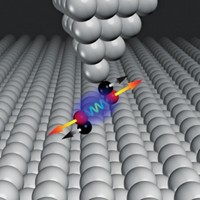Advertisement
Grab your lab coat. Let's get started
Welcome!
Welcome!
Create an account below to get 6 C&EN articles per month, receive newsletters and more - all free.
It seems this is your first time logging in online. Please enter the following information to continue.
As an ACS member you automatically get access to this site. All we need is few more details to create your reading experience.
Not you? Sign in with a different account.
Not you? Sign in with a different account.
ERROR 1
ERROR 1
ERROR 2
ERROR 2
ERROR 2
ERROR 2
ERROR 2
Password and Confirm password must match.
If you have an ACS member number, please enter it here so we can link this account to your membership. (optional)
ERROR 2
ACS values your privacy. By submitting your information, you are gaining access to C&EN and subscribing to our weekly newsletter. We use the information you provide to make your reading experience better, and we will never sell your data to third party members.
Synthesis
Proton bond observed in a better light
April 16, 2007
| A version of this story appeared in
Volume 85, Issue 16
A clearer picture of the intermolecular proton bond that forms when a proton (hydrogen ion) is shared between two Lewis-base solvent molecules is now possible thanks to a gas-phase ion spectroscopy study carried out by J. Robert Roscioli, Laura R. McCunn, and Mark A. Johnson of Yale University (Science 2007, 316, 249). Lewis bases, such as water, alcohols, and ammonia, can use a lone pair of electrons to trap protons to form cations. When two molecules compete for the same proton, a complex forms with the proton bound in the middle. This binding motif is important in biological and physical proton-transport processes, the researchers note. Previous infrared spectroscopy studies of these complexes in the solid and liquid phases have yielded broad absorption peaks bearing only modest information. But in the gas phase, the infrared spectra of complexes studied by the Yale team using argon nanomatrix methods showed sharp bands that clarify how the proton affinities and molecular vibrations of the flanking bases influence the confined proton.



Join the conversation
Contact the reporter
Submit a Letter to the Editor for publication
Engage with us on Twitter